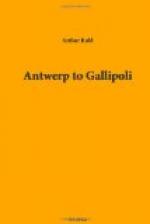A Turkish soldier, the only other occupant of the deck, surveyed these preparations impassively; then, taking off his boots, climbed on a settee and stood there in his big bare feet, with folded hands, facing, as he thought, toward Mecca. The boat was headed southwest, and he looked to starboard, so that he faced, as a matter of fact, nearly due west. He had knelt and touched his forehead twice to the bench, and was going on with the Mussulman prayer when the captain, a rather elegant young man who had served in the navy, murmured something as he passed. The soldier looked round thoughtfully; without embarrassment, surprise, or hurry stepped from the settee, pointed it toward the Asiatic shore, and, stepping up again, resumed his devotions.
Five times that day, as the faithful are commanded, he said his prayer— a sight that followed us everywhere that week. One evening after dusk, on another boat, a fireman came up from below, climbed on a settee, and began his prayer. Several passengers, who had not seen him in the dark, walked in front of him. He broke off, reviled them in true fire-room style, then with a wide gesture, as though sweeping the air clear ahead of him all the way to the holy city, began at the beginning again. Soldiers up in the Gallipoli hills, the captain on the bridge, a stevedore working on a lighter in the blaze of noon with the winch engines squealing round him—you turn round to find a man, busy the moment before, standing like a statue, hands folded in front of him, facing the east. Nothing stops him; no one seems to see him; he stands invisible in the visible world—in a world apart, ’indeed, to which the curious, self-conscious Westerner is not admitted, where, doubtless, he is no more than the dust which the other shakes from his feet before he is fit to address his God.
The Marmora narrowed, we passed Gallipoli on the European side, where the English and French hostages had had their curious adventure the week before, and on into the Dardanelles proper and the zone of war. It was some forty miles down this salt-water river (four miles wide at its widest, and between the forts of Chanak Kale and Kilid Bahr, near its lower end, a fraction over a mile) from the Marmora gateway to the Aegean. On the left were Lapsaki and the green hills of Asia, cultivated to their very tops; on the right Europe and the brown hills of the peninsula, now filled with guns and horses and men.
Over there, up that narrow strip of Europe, running down between the Dardanelles and the Aegean, the Allies had been trying for weeks to force their way to Constantinople. They had begun in February, you will recall, when they bombarded the forts at the outer entrance to the Dardanelles—Sedd ul Bahron the European side, at the tip of the peninsula, and Kum Kale, across the bay on the Asiatic shore.. These forts occupy somewhat the relation to Constantinople that Sandy Hook does to New York, although much farther away—they face, that is to say, the open sea, and the guns of the fleet, heavier than those of the old forts, could stand off at a safe distance and demolish them.




